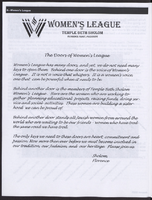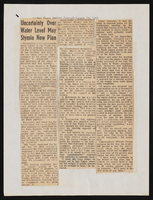Search the Special Collections and Archives Portal
Search Results
Burton Cohen oral history interview
Identifier
Abstract
Oral history interview with Burton Cohen conducted by Michael Geeser on November 14, 2005 for the I Remember When: Recollections from Las Vegas Jewish Leaders Oral History Project. He talks about his career as a casino executive, celebrities in Las Vegas, Nevada, the role of organized crime in the city, and about executives of other casinos. He also answers questions from the audience.
Archival Collection
Carrie Christensen and Orien Stevens oral history interview
Identifier
Abstract
Oral history interview with Carrie Christensen and Orien “Buster” Stevens conducted by Bernard Timberg on February 04, 1974 for the Ralph Roske Oral History Project on Early Las Vegas. In this interview, Christensen and Stevens discuss segregation in Boulder City, Nevada, their interactions with Native Americans, and the Westside community in Las Vegas, Nevada. They also talk about the Union Pacific Railroad, the influx of migrants and growth of churches during World War II. Stevens describes his experience working on Hoover Dam (Boulder Dam) as well as the railroad starting at age fifteen. Christensen discusses her personal life, her religious opinions, and mottos.
Archival Collection
Blue Diamond History Committee Collection
Identifier
Abstract
The Blue Diamond History Committee Collection (1920s-2012) contains materials related to the history of the Blue Diamond Mine and nearby village located about twenty-five miles outside of Las Vegas, Nevada. The collection contains materials including environmental reports, photographs of the mine and its employees and their families, maps, a photocopy of a diary, mine operation records and accident reports, community calendars, and correspondence and property documents of the local post office.
Archival Collection
University of Nevada, Las Vegas Lied Library Architectural Records
Identifier
Abstract
The University of Nevada, Las Vegas Lied Library Architectural Records (1965-2010) are comprised of drawings and documents created by the American architecture firms of Welles Pugsley Architects and Leo A Daly Architects, as well as their associated consultants, engineers, and other professional collaborators. This collection documents the design and construction of Lied Library at the University of Nevada, Las Vegas (UNLV). The materials feature both hand-drawn and computer generated architectural drawings, ranging from preliminary sketches and artist renderings to schematic drawings and construction documents.
Archival Collection
Elmo C. Bruner Architectural and Real Estate Appraisal Records
Identifier
Abstract
The Elmo C. Bruner Architectural and Real Estate Appraisal Records date from 1937 to 1996 and contain architectural and appraisal records from Las Vegas, Nevada. Bruner joined A.L. Worswick’s office in 1947, taking it over following Worswick’s retirement in 1954. In 1958, Bruner formed the Las Vegas Appraisal and Finance Corporation. The bulk of the collection consists of appraisal records for residential and commercial properties in Las Vegas, Henderson, and North Las Vegas. These records provide a detailed look at the urban development of the region as well as building design, style, and neighborhood characteristics. The architectural drawings highlight the work of Worswick and Bruner, including Frazier Hall at Las Vegas High School and the original adobe administration building at McCarran Airport.
Archival Collection
National Congress of American Indians (NCAI) subject files, 1997-2011
Level of Description
Scope and Contents
The National Congress of American Indians (NCAI) subject files date from 1997 to 2011 and include materials produced by and about NCAI and the organization’s efforts to represent the interests of Native American governments and communities. Materials include reports, legislative documents, newsletters, publications, pamphlets, memos, press releases, agendas, informational booklets, and newspaper articles. The majority of the subseries focuses on joint NCAI and National Conference of State Legislatures (NCSL) projects about health, renewable energy, government-to-government relationships, and Native American sovereignty.
Additional materials relating to NCAI can be found in the National Indian Gaming Association (NIGA) and the National Congress of American Indians (NCAI) Joint Task Force files and the National Congress of American Indians (NCAI) and Bureau of Indian Affairs (BIA) Data Management, Needs Assessment, and Auditing Workgroup files. Materials directly related to Spilde’s activities as a member of the task force and workgroup were placed in those subseries. Other materials about NCAI were placed in the NCAI subject files.
Archival Collection
Collection Name: Katherine A. Spilde Papers on Native American Gaming
Box/Folder: N/A
Archival Component




